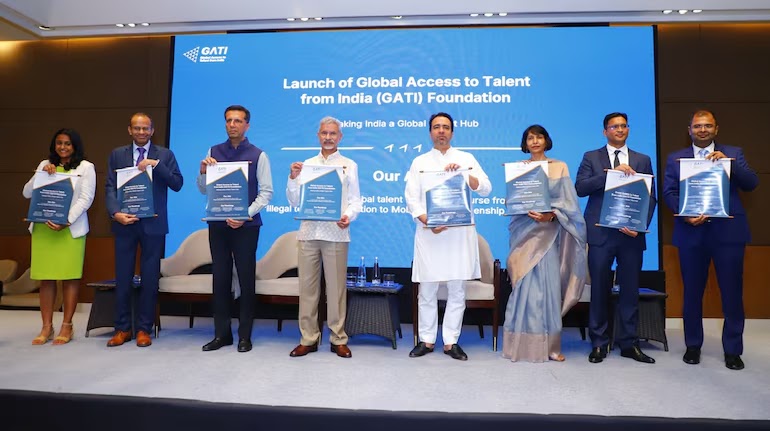Scope for Improvement in Internship Scheme, but India is a Global Talent Hub, Say Ashish Dhawan & Manish Sabharwal
Ashish Dhawan, educationist and co-founder of Ashoka University, believes that while India’s internship and apprenticeship programs have taught the government important lessons, there’s still plenty of room for improvement. In an interview with Moneycontrol, Dhawan pointed out that India holds a strong position as a global talent pool but faces what he calls “regulatory cholesterol” when it comes to training and skilling its workforce. “That’s why the government has shifted more attention towards apprenticeships and internships. There’s been progress, but we still have work to do. Both the central and state governments are aware of this,” Dhawan said.
In July 2024, the Union government launched the PM-Internship Scheme (PMIS), which aims to offer internships to around 10 million young people over the next five years, partnering with India’s top 500 companies. In its initial round, the scheme saw 28,141 candidates accept internship offers.
Manish Sabharwal, vice-chairman of TeamLease Services, emphasized that only two countries today can supply workers at large scale—both blue- and white-collar—and that’s India and China. “But China faces language and trust issues, making India the preferred global partner,” Sabharwal added.
The two were speaking after the launch of the Global Access to Talent from India (GATI) foundation, which focuses on mobilizing Indian workers for international opportunities and helping clear regulatory roadblocks. “GATI will help reduce information gaps and bring key stakeholders together,” Dhawan explained.
Key Highlights from the Interview
Q: You’re pushing for skilling Indian workers for global jobs, even as many countries tighten borders. Why now?
Manish Sabharwal: The backlash is mainly against illegal migration, not legal labor flows. Earlier, only highly skilled workers were in demand, but now there’s a broader need. India already has a 17 million-strong diaspora, and we believe it can grow to 30 million. Our remittances could rise from $120 billion to $300 billion. Many global sectors—retail, hospitality, healthcare, construction—simply can’t sustain themselves without an influx of workers.
Also check: first4roofing | first4driveways
Q: Can India realistically reach $300 billion in remittances by 2030, roughly 4–4.5% of GDP?
Ashish Dhawan: The Philippines, with a higher per capita GDP, has remittances accounting for 8.5% of its GDP. We’re aiming for a move from 3% to 4.5%. India already has about 35% market share among Gulf country migrants, but in Europe, our presence is negligible. We’ve identified 20 in-demand skills across both blue- and white-collar roles that India can supply. Despite some headwinds in the U.S., there’s real opportunity elsewhere—and GATI can help us tap into that.
Q: Will GATI address the language barrier in foreign job markets?
Ashish Dhawan: Absolutely. Language training is critical, especially for non-English-speaking countries. It will require investment in training and consideration of financing models. But the wage premiums earned abroad can help cover these costs.
Q: Are state governments involved in this effort?
Manish Sabharwal: The Ministry of External Affairs (MEA) must take the lead, but this can’t be tackled in isolation. It needs a horizontal, whole-of-government approach. For instance, there are 300,000 Nepalese workers in Japan, but only 30,000 Indians. We can significantly increase that.
Q: How do you ensure proper skilling for international roles?
Manish Sabharwal: Problems arise when skilling efforts are supply-driven rather than demand-driven. Migration will only happen when workers have the right skill sets, including any certifications required by the receiving countries. It’s essentially an engineering challenge.
Q: How important is private-sector support for success?
Ashish Dhawan: The private sector is essential for skilling and certification. We need to shape the supply side. For example, if there are 30 Japanese language trainers operating in Nepal, we could invite them to set up centers in Assam—with the state facilitating their entry. Financial support, like credit guarantees, can be provided to these companies. The government can engage in dialogue with destination countries to understand challenges, while GATI coordinates among the MEA, states, and the private sector. India is a large-scale talent provider.
Q: The guest worker program has failed in some places. Why would it work now? And can’t other countries replicate India’s approach?
Manish Sabharwal: Guest worker programs fail where immigration laws aren’t enforced, but they succeed elsewhere, like in Saudi Arabia. Only India and China can provide workers at scale—but China faces language and trust issues, positioning India as the better option.
Q: How will India tackle its own regulatory bottlenecks while ensuring domestic labor is not sidelined?
Ashish Dhawan: The government recognizes the challenges and has increasingly turned to apprenticeships and internships, learning along the way. But there’s still room for improvement. At GATI, we aim to reduce regulatory hurdles and improve coordination, while the government and private sector handle broader implementation.
Q: Have you identified target countries for deploying Indian workers?
Ashish Dhawan: Initially, we’re focusing on East Asia—Japan, South Korea—and Germany. These markets have strong government-to-government agreements, large potential, and currently, low Indian market share.

Comments
Post a Comment